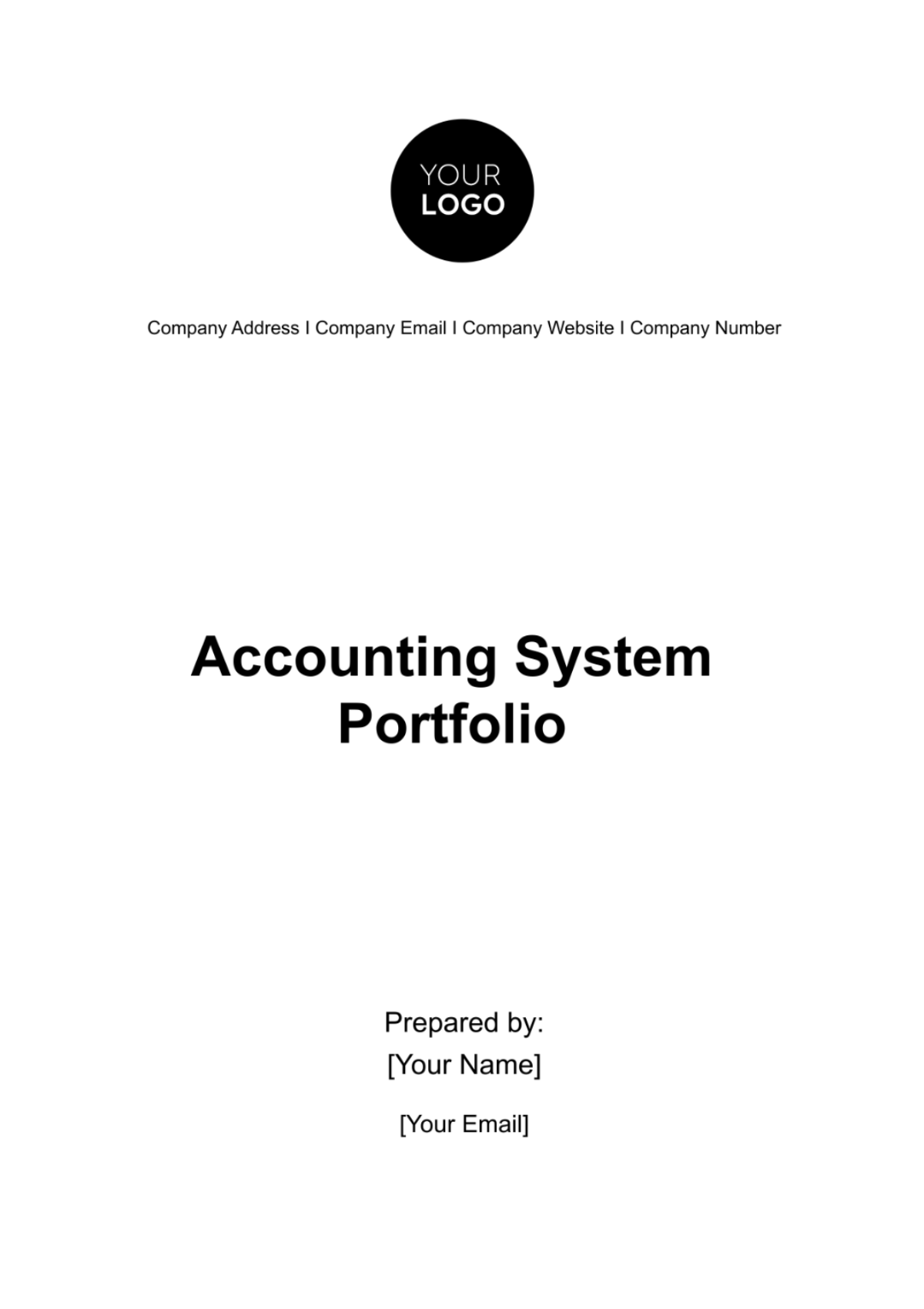Free Accounting System Portfolio

TABLE OF CONTENTS
Introduction.................................................................................................................3
Overview......................................................................................................................4
Key Features................................................................................................................5
General Ledger Summary...........................................................................................6
Accounts Receivable Aging Report ..........................................................................7
Budget vs Actual Report.............................................................................................8
Financial Risk Management........................................................................................9
Conclusion....................................................................................................................10
Introduction
This document serves as an introduction to the accounting system adopted by [Your Company Name]. The purpose of this portfolio is to systematically present the functionalities and capabilities of our advanced accounting system. It outlines the system's core features, operational framework, and its utility in enhancing the financial management of [Your Company Name].
The accounting system at [Your Company Name] is engineered to provide precision and efficiency in financial transactions and reporting. It aligns with the latest regulatory standards and integrates sophisticated technologies for optimal financial management. This portfolio includes detailed sections on each component of the system, along with illustrative tables containing fictional data, demonstrating the system's efficacy in managing and reporting the financial activities of [Your Company Name].
Overview
The Accounting System for [Your Company Name] is a financial management solution designed to streamline financial processes and reporting. It offers robust functionalities in areas such as general ledger management, accounts payable and receivable, budgeting, and financial reporting. This system is equipped with advanced analytics to provide real-time financial insights, aiding strategic decision-making.
Key Features
This section delineates the principal features of the accounting system implemented at [Your Company Name]. The system's design is centered on enhancing financial management through automation, accuracy, and comprehensive reporting. The key features detailed below have been strategically developed to address the multifaceted financial operations of the company, ensuring that each aspect of financial management is effectively catered to.
General Ledger Management
This feature serves as the backbone of the accounting system, providing a central repository for all financial data. It is designed to handle complex transactions with ease, updating in real-time to reflect the most current financial status. The general ledger management system supports various accounting methodologies and is capable of handling large volumes of data, ensuring accuracy and consistency in financial records.
Accounts Payable and Receivable
The system streamlines the management of accounts payable and receivable by automating invoice processing and enhancing the tracking of payments and collections. This functionality reduces manual data entry errors and accelerates the payment cycle, thereby improving cash flow management. It also includes advanced features for handling vendor and customer accounts, supporting electronic payments, and providing detailed aging reports for better liquidity analysis.
Budgeting and Forecasting
Our accounting system offers robust tools for budgeting and forecasting, enabling [Your Company Name] to plan financial operations with greater precision. It allows for the creation of detailed, multi-level budgets and facilitates the comparison of actual financial performance against these budgets. The system's forecasting capabilities are based on historical data and current trends, providing insights for more accurate future financial planning.
Financial Reporting and Analysis
The system is equipped with powerful reporting and analysis tools that generate comprehensive financial statements and customizable reports. These tools provide vital insights into the financial health of [Your Company Name], supporting strategic decision-making. The system's analytical capabilities include trend analysis, variance analysis, and key financial ratios, all of which are crucial for in-depth financial analysis and reporting. The flexibility to tailor reports to specific organizational needs makes this feature invaluable for both internal management and external reporting requirements.
The accounting system at [Your Company Name] represents a solution, crafted to support and enhance the company's financial operations. From the robust management of the general ledger to the intricacies of budgeting and financial analysis, each feature is aligned with the goal of fostering financial accuracy and efficiency. This system provides strategic insights essential for informed decision-making, thereby positioning [Your Company Name] at the forefront of financial management excellence.
General Ledger Summary
The General Ledger Summary is a critical component of [Your Company Name]'s accounting system, serving as the central framework for all financial transaction recording. This section of the system is designed to ensure the integrity and accuracy of financial data, which is pivotal for effective financial management and reporting.
Key Functionalities and Benefits:
Comprehensive Transaction Recording:
The General Ledger Summary is structured to capture every financial transaction, categorizing each into appropriate accounts. This includes revenues, expenses, assets, liabilities, and equity transactions, ensuring a complete financial picture.
Real-Time Data Updating:
Transactions are updated in real-time, offering an immediate reflection of the financial status. This feature is crucial for maintaining up-to-date financial records, which is essential for timely decision-making and financial reporting.
Multi-Dimensional Reporting:
The system allows for the creation of multi-dimensional reports, providing insights into various aspects of the company's finances. This includes departmental, project-based, and overall company financial reports, which are vital for internal analysis and external reporting.
Automated Reconciliation:
The General Ledger Summary includes automated reconciliation capabilities, significantly reducing the time and effort required in manual reconciliations. This enhances the accuracy of financial statements and supports the integrity of financial reporting.
Audit Trail and Compliance:
Every transaction recorded in the General Ledger comes with a detailed audit trail, which is crucial for compliance and auditing purposes. This feature ensures transparency and accountability in financial reporting.
Customizable Chart of Accounts:
The system offers a customizable chart of accounts, allowing [Your Company Name] to tailor the financial recording process to its specific needs. This flexibility supports the unique operational and reporting requirements of the company.
Integration with Other Financial Modules:
The General Ledger Summary seamlessly integrates with other financial modules like Accounts Payable, Accounts Receivable, and Payroll. This integration ensures consistency and accuracy across all financial systems within the company.
Sample Data of General Ledger Summary:
Account Code | Account Name | Debit | Credit |
|---|---|---|---|
1010 | Cash | $150,000 | $30,000 |
The General Ledger Summary in [Your Company Name]'s accounting system is a robust and versatile tool, essential for accurate financial recording and reporting. Its comprehensive functionalities ensures compliance with financial standards and provide a strong foundation for financial analysis and strategic decision-making. This system is indispensable in maintaining the financial health and transparency of [Your Company Name].
Accounts Receivable Aging Report
The Accounts Receivable Aging Report is a vital component of [Your Company Name]'s financial management system. This report offers a detailed view of the outstanding receivables, categorized by the duration for which they have been outstanding. It plays a crucial role in managing the company's cash flow, assessing customer creditworthiness, and determining collection strategies.
Key Functionalities and Benefits:
Age-Based Categorization:
Receivables are categorized based on age, typically in segments such as [0-30 days], [31-60 days], [61-90 days], and over [90 days]. This categorization helps in identifying overdue payments and prioritizing collection efforts.
Customer Account Analysis:
The report provides a detailed analysis of each customer account, giving insights into payment patterns and highlighting any potential risks associated with credit sales to particular customers.
Enhanced Cash Flow Management:
By regularly reviewing the Aging Report, [Your Company Name] can effectively manage its cash flow. Understanding the timing of cash inflows is crucial for meeting operational expenses and planning for future investments.
Risk Mitigation:
Early identification of overdue accounts allows the company to take proactive measures to mitigate risk, such as revising credit terms, implementing stricter collection processes, or considering bad debt provisions.
Customizable Reporting:
The system allows customization of the Aging Report to suit specific business needs. This might include additional segmentation, detailed notes on each account, or integration with CRM systems for a comprehensive customer view.
Automated Reminders and Alerts:
The system can generate automated reminders and alerts for overdue accounts, both to internal staff for follow-up actions and directly to customers, thereby streamlining the collection process.
Historical Data Analysis:
The report provides access to historical data, enabling trend analysis over time. This helps in understanding seasonal patterns in receivables and adjusting credit policies accordingly.
Integration with Financial Statements:
The Aging Report is integrated with the overall financial statements, providing a clear picture of the company's financial health and contributing to accurate financial reporting.
Sample Data of Accounts Receivable Aging Report:
Customer Name | 0-30 Days | 31-60 Days | Over 60 Days | Total Due |
|---|---|---|---|---|
[Company Name] | $5,000 | $3,000 | $1,000 | $9,000 |
The Accounts Receivable Aging Report within [Your Company Name]'s accounting system is a sophisticated tool that enhances the management of receivables. Its features aid in effective cash flow management, risk mitigation, and strategic financial planning. This report is essential for maintaining a healthy balance between sales on credit and timely collections, thereby ensuring the financial stability and liquidity of [Your Company Name].
Budget vs Actual Report
The Budget vs Actual Report is a pivotal component in [Your Company Name]'s financial management framework. This report provides a comprehensive comparison of the company's budgeted financial expectations against the actual financial performance. It is an indispensable tool for financial monitoring, strategic planning, and performance evaluation.
Key Functionalities and Benefits:
Detailed Variance Analysis:
This component of the report delineates the differences between the budgeted projections and the actual financial outcomes. Such an analysis is pivotal for pinpointing specific areas where [Your Company Name] exceeds or falls short of its financial objectives. By dissecting these variances, the company gains vital insights into operational efficiencies and inefficiencies.
Performance Monitoring:
The system's capability to consistently compare budgeted forecasts against actual financial results enables ongoing scrutiny of [Your Company Name]'s financial health. This continuous monitoring is instrumental in swiftly detecting financial discrepancies and facilitating prompt remedial measures to realign with financial goals.
Strategic Decision Making:
The Budget vs Actual Report serves as a cornerstone for strategic financial planning at [Your Company Name]. It provides a clear understanding of the reasons behind financial variances, thereby equipping management with the data needed to make informed decisions regarding resource distribution, operational modifications, and future budget preparation.
Departmental and Project Analysis:
The system can generate reports for specific departments or projects, providing granular insights into their financial performance. This feature is particularly useful for large organizations with multiple cost centers.
Flexible Time Periods:
This reporting feature allows for the generation of specific reports tailored to individual departments or projects within [Your Company Name]. It offers detailed insights into the financial performance of distinct segments of the organization, making it an invaluable tool for larger entities with diverse operational areas.
Forecasting Improvement:
Historical analysis of budget variances enhances the accuracy of future financial forecasts. Learning from past trends and adjusting assumptions lead to more realistic budgeting.
Enhanced Accountability and Transparency:
By offering transparent comparisons between budgeted figures and actual financial results, the report fosters a culture of accountability within [Your Company Name]. It also bolsters transparency in financial reporting, an essential factor in maintaining the confidence and trust of stakeholders.
Integration with Other Financial Systems:
The Budget vs Actual Report is seamlessly integrated with other key financial systems within [Your Company Name], including the General Ledger, Accounts Payable, and Accounts Receivable. This integration ensures a unified and comprehensive approach to financial analysis, enhancing the overall effectiveness of the company's financial management strategies.
Sample Data of Budget vs Actual Report:
Account Code | Account Name | Budgeted | Actual | Variance |
|---|---|---|---|---|
6010 | Marketing Expense | $40,000 | $35,000 | $5,000 |
The Budget vs Actual Report within [Your Company Name]'s accounting system is an essential tool for effective financial management. It provides critical insights into financial performance, facilitates strategic decision-making, and enhances accountability and transparency. This report is integral to ensuring that [Your Company Name] remains aligned with its financial objectives, adapts to changing business conditions, and achieves sustained financial success.
Financial Risk Management
Financial Risk Management is a crucial aspect of [Your Company Name]'s accounting system. This section focuses on identifying, analyzing, and mitigating financial risks that may impact the company's financial health and operational efficiency. The system is designed to proactively manage risks associated with market volatility, credit, liquidity, and operational factors.
Risk Identification and Assessment:
The accounting system is equipped with sophisticated tools to methodically identify and evaluate a spectrum of financial risks, encompassing credit, market, and operational risks. This process leverages a combination of historical data analysis, current market trend evaluation, and predictive modeling to anticipate potential risk factors accurately. The assessment tools are designed to recognize subtle risk indicators, providing an early warning system for financial vulnerabilities.
Customizable Risk Parameters:
[Your Company Name] is empowered to define and adjust risk parameters uniquely aligned with its specific risk tolerance and business model. This customization allows for a dynamic approach to risk management, enabling the company to manage its risk profile proactively. The system's flexibility ensures that risk management strategies are congruent with evolving business objectives and market conditions.
Real-time Monitoring and Alerts:
The system employs a continuous monitoring mechanism that tracks all financial transactions and activities, flagging anomalies that indicate potential risk exposures. Real-time alerts are issued to relevant stakeholders, facilitating swift and informed decision-making. This immediate response capability is essential in mitigating risks before they escalate, ensuring financial stability.
Integrated Risk Reporting:
Risk reports generated by the system are integrated with other financial reporting modules, providing a cohesive and in-depth view of the company's overall financial health and risk exposure. These reports are instrumental in strategic planning, as they combine risk data with financial performance metrics, offering a comprehensive financial overview for informed decision-making.
Scenario Analysis and Stress Testing:
The system includes advanced tools for conducting detailed scenario analysis and stress testing. These tools allow [Your Company Name] to simulate various adverse financial conditions, assessing the potential impacts on the company's financial health. This forward-looking approach is crucial for developing robust strategies to withstand unpredictable market conditions and economic fluctuations.
Liquidity Management:
Liquidity risk management is a key feature, with the system providing precise monitoring of cash flow projections. It ensures that [Your Company Name] maintains adequate liquidity to meet its short-term financial obligations, thereby safeguarding against liquidity crunch scenarios. This feature is vital for maintaining operational continuity and financial solvency.
Credit Risk Management:
The system incorporates a thorough approach to managing credit risk. It includes functionalities for assessing the creditworthiness of customers, setting appropriate credit limits, and monitoring credit exposures. This proactive management of credit risk helps in minimizing the incidence of bad debts and optimizing the company's credit portfolio.
Compliance and Regulatory Reporting:
Adherence to regulatory standards and compliance is a cornerstone of the system. It features comprehensive tools for generating reports in line with the requirements of various regulatory bodies. This not only ensures compliance with financial regulations but also mitigates legal and regulatory risks associated with non-compliance.
The Financial Risk Management component of [Your Company Name]'s accounting system is instrumental in safeguarding the company against financial uncertainties. By providing the tools for risk assessment, real-time monitoring, and scenario planning, the system plays a vital role in maintaining the financial stability and integrity of [Your Company Name].
Conclusion
This portfolio demonstrates the proficiency of [Your Company Name]'s Accounting System in managing and accurately reporting financial data. Precisely tailored to align with the unique requirements of the company, the system exemplifies the epitome of efficiency and precision in financial management. It stands as a testament to the company's commitment to upholding the highest standards of financial integrity and operational excellence. Through its features and functionalities, the system not only meets but surpasses the expectations for effective financial administration in a contemporary business sector.
- 100% Customizable, free editor
- Access 1 Million+ Templates, photo’s & graphics
- Download or share as a template
- Click and replace photos, graphics, text, backgrounds
- Resize, crop, AI write & more
- Access advanced editor
Boost your accounting system organization with Template.net's Accounting System Portfolio Template. This editable and customizable tool streamlines your documentation process, offering a cleaner presentation of your financial data. Modify effortlessly using our Ai Editor Tool to fit your unique specifications. Efficiency and professionalism made easy with Template.net's portfolio template.





























